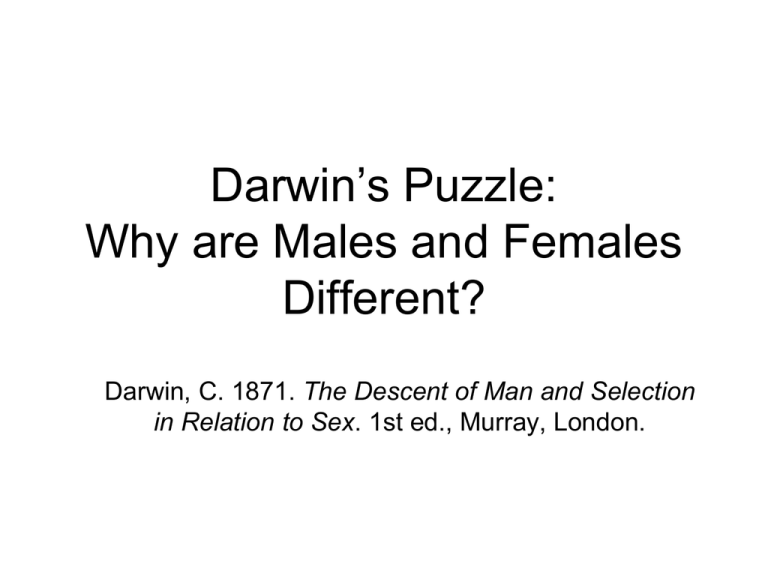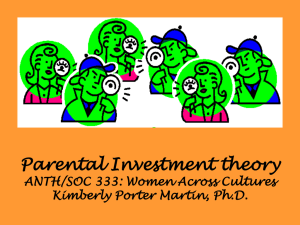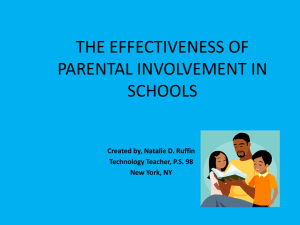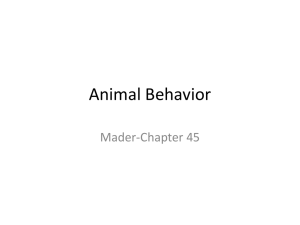
Darwin’s Puzzle:
Why are Males and Females
Different?
Darwin, C. 1871. The Descent of Man and Selection
in Relation to Sex. 1st ed., Murray, London.
Parental Investment and
Sexual Selection
Trivers 1972
Assumption
• Assumption: Every organism has adaptations
that function to facilitate reproduction
• Members of a population/species live in the
same environment, so why do some animals
have different adaptations than others?
• Morphs: age, sex, others
• SEX: male and female adaptations are
different
• WHY?
Parental Investment
• Any investment by the
parent in an individual
offspring that
increases the
offspring’s chance of
surviving (and hence
reproductive success)
at the cost of the
parent’s ability to
invest in other
offspring” (Trivers
1972)
Sperm vs. Egg
In sexuallyreproducing
species, the
relative size of
gametes define
who is male and
who is female.
Nurturant Females
• In most animals, and
almost all mammals,
females provide far more
parental investment than
just the egg
• Internal fertilization
protects, but at a cost
• Cod vs. gorillas
• Humans (mammals):
– Prolonged internal gestation
(pregnancy)
– Placentation
– Lactation
Competitive Males
• Males are fighting with each other to mate
with as many females as possible
• More females = more offspring (sharp
contrast to females)
High male Variance:
Elephant seals
• One breeding
season, 115 males
were present, but the
5 highest ranking
ones in the hierarchy
(the big, tough ones)
performed 123 of
144 observed
copulations
Sexual Selection and Parental
Investment Theory
• For members of the sex that invests more in
offspring, reproductive success is limited by
the amount of resources an individual can
secure for itself and it’s offspring
• For members of the sex that invests less in
offspring, reproductive success is limited by
the number of mates one can acquire
Sexual Selection and Parental
Investment Theory
• What of it?
• Selection acted on males differently than it acted on
females
• Specifically, differences in parenting strategies cause
differences in adaptations
• Sex that invests more: adaptations to survive and get
resources for offspring
• Sex that invests less: adaptations to help them get as
many mates as possible
• It explains why, in many species, males look and
behave differently than females
Sexual Selection and Parental
Investment Theory
• Explains primary sex differences (uteruses
vs. testes)
• Explains secondary sex differences
– Differences in weaponry
(intrasexual selection)
– Differences in ornaments
(intersexual selection)
– When the sexes have different adaptations, they
are “sexually dimorphic”
Sexual Selection and Parental
Investment Theory
• Intrasexual selection occurs when
members of one sex fight with each
other to gain sexual access to members
of the other sex
• Results in weaponry
• Examples…
Sexual Selection and Parental
Investment Theory
• Intrasexual selection:weaponry/size differentiation
Sexual Selection and Parental
Investment Theory
• Intrasexual selection: lack of differentiation
Sexual Selection and Parental
Investment Theory
• Intrasexual selection: behavior
Sexual Selection and Parental
Investment Theory
• Intrasexual selection
• Causes members of the competitive sex
to die younger than the competed-for
sex
• …willingly!!!
Sexual Selection and Parental
Investment Theory
• Intrasexual selection occurs when
members of one sex fight with each
other to gain sexual access to members
of the other sex
• Intersexual selection….
Sexual Selection and Parental
Investment Theory
• Intersexual
selection:
ornaments in
one sex and
not the other
Sexual Selection and Parental
Investment Theory
• Intersexual
selection:
ornaments are
not always
pretty by
human
standards
Sexual Selection and Parental
Investment Theory
• Intersexual selection: why ornaments?
• Arbitrary (you just know you want your
offspring to inherit those traits)
• Good genes
• Low parasite load
• Handicap principle
• Combination
Sexual Selection and Parental
Investment Theory
Intersexual selection
+
Intrasexual selection
=
Sexual Selection and Parental
Investment Theory
• Why not just say
“females are limited
by resources and
males are limited by
access to females”?
• The exceptions that
prove the rule
phalarope
seahorse
Next Topic
• Altruism
The Problem of Altruism
Kin Selection
Reciprocal Altruism
Altruism
• Doing something that benefits another
individual’s reproductive success at a
cost to one’s own reproductive success
• If natural selection is all about
competition to reproduce, how could
there possibly be adaptations that
cause one to be altruistic?
• Two solutions…
Kin Selection
• William Hamilton (bees)
• Not about helping the individual but about helping the
gene
• Hamilton’s Rule: C<Br
• You share genes with your relatives
• A gene that causes its bearer to be altruistic will only
spread in a population if the cost to the altruist (C) is
less than the benefit to the recipient (B), multiplied
(devalued) by the coefficient of relatedness (r)
Kin Selection
• Mom, dad, full siblings: 50% (1/2)
• Grandparents, 1st uncles and aunts,
and half siblings: 25% (1/4)
• First cousins: 12.5% (1/8)
• Identical twins: 100% (very un likely to
be a significant factor in the evolution of
nonhuman primate behavior)
• Bees: weird; workers are more closely related to
each other than to the queen; Hamilton’s work
Reciprocal Altruism
• Altruism among Unrelated individuals
• I.e., “exchange”
• Trivers (again)
Reciprocal Altruism
• Not very common in nonhuman
primates
• Very common in humans
• Chimps exchange coalitional support
• See also capuchins in Perry book (later)










